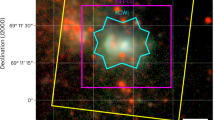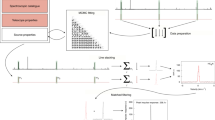Abstract
INTERSTELLAR hydrogen isocyanide (HNC) was first tentatively identified1 on the basis of a calculated frequency for the J =1→0 transition of the most abundant isotopic species H14N12C. The observed interstellar line was quite strong and widespread in the galaxy. A more definitive identification of the observed U90.7 emission line (90,663.6 MHz)2 by searching for other isotopes was not possible because of the large uncertainties in the calculated molecular structure of HNC, and the corresponding large uncertainties in the calculated transition frequencies for H14N13C and H15N12C. Hydrogen isocyanide is very short lived in terrestrial laboratory conditions, and therefore it has proven difficult to measure the rotational spectrum directly. The J = 0→1 transition has, however, been recently measured independently by three groups3–5 and the frequency of the major isotope is in excellent agreement with that of U90.7. The laboratory spectroscopy has also yielded the 13C isotope transition frequency4. Immediately following this measurement, we searched for and detected the HN13C J =1→0 rotational spectral line at 87,090.6 MHz in the galactic molecular source W51 (Fig. 1) on the NRAO 11-m telescope in March, 1976. Because of calibration problems with our receiver, we simultaneously observed the 12C isotope so that relative abundance determinations might ultimately be made from our data. Appropriately, W51 was the source in which Snyder and Buhl first detected the J = 1→0 transition of HN12C. In addition, the HN13C line was detected in DR21, Sag B2, and possibly also NGC2264 and IRC + 10°216 (Figs 2–5). All of these sources also showed the HN12C emission line. In addition, we detected HN12C in W3 (Fig. 6), but were unable to detect the 13C isotope there due to equipment failure. These results are summarised in Table 1.
This is a preview of subscription content, access via your institution
Access options
Subscribe to this journal
Receive 51 print issues and online access
$199.00 per year
only $3.90 per issue
Buy this article
- Purchase on Springer Link
- Instant access to full article PDF
Prices may be subject to local taxes which are calculated during checkout
Similar content being viewed by others
References
Snyder, L. E., and Buhl, D., Ann. N. Y. Acad. Sci., 194, 17 (1972).
Zuckerman, B., Morris, M., Palmer, P., and Turner, B. E., Astrophys. J. Lett., 173, L125 (1972).
Saykally, R. J., Szanto, T. G., Anderson, T. G., and Woods, R. C., Astrophys. J. Lett., 204, L143 (1976).
Blackman, G. L., Brown, R. D., Godfrey, P. D., and Gunn, H. I., Nature (in the press).
Creswell, R. A., Pearson, E. F., Winnewisser, M., and Winnewisser, G., Z. Naturforsch., 31a, 221 (1976).
Snyder, L. E., and Hollis, J. M., Astrophys. J. Lett., 204, L139 (1976).
Turner, B. E., Astrophys. J. Lett., 193, L83 (1974).
Turner, B. E., Zuckerman, B., Palmer, P., and Morris, M., Astrophys. J., 186, 123 (1973).
Author information
Authors and Affiliations
Rights and permissions
About this article
Cite this article
BROWN, R., GODFREY, P., STOREY, J. et al. Detection of interstellar HN13C. Nature 262, 672–674 (1976). https://doi.org/10.1038/262672a0
Received:
Accepted:
Issue Date:
DOI: https://doi.org/10.1038/262672a0
This article is cited by
-
Theoretical Study of Possible Reaction Mechanisms for the Formation of Carbodiimide in the Interstellar Medium (ISM) and Polarizabilities of Carbodiimide
Origins of Life and Evolution of Biospheres (2019)
-
Ab initio study of ternary radical–molecule complexes between HCN(HNC) and HO(HS) species
Structural Chemistry (2013)
-
Ab initio study of the cooperativity between NH···N and NH···C hydrogen bonds in H3N–HNC–HNC complex
Theoretical Chemistry Accounts (2010)
-
HCN/HNC versus HCN+?/HNC+? ? zur Ursache der Stabilit�tsumkehr beim �bergang von den Neutralmolek�len zu den Radikalkationen
Naturwissenschaften (1982)
-
A list of interstellar molecules
Nature (1980)
Comments
By submitting a comment you agree to abide by our Terms and Community Guidelines. If you find something abusive or that does not comply with our terms or guidelines please flag it as inappropriate.



